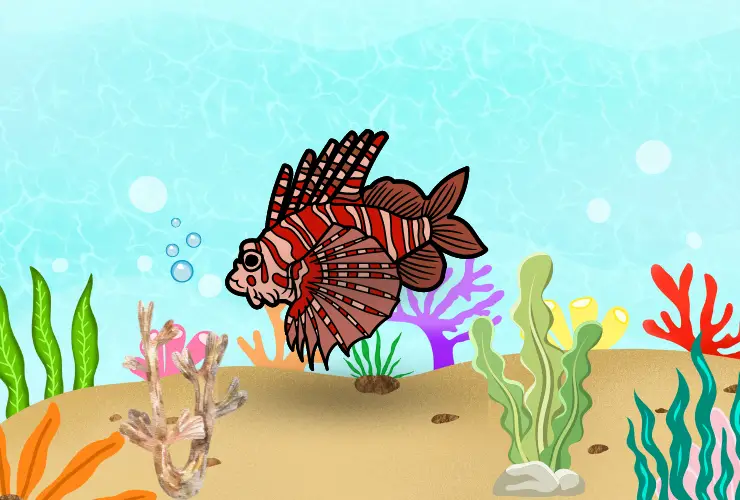The Red Lionfish is known for their striking appearance and venomous spines. Native to the Indian and Pacific Oceans, they can now be found in the western Atlantic Ocean, including parts of the Caribbean Sea.
However, this invasive species has caused immense damage to its new habitats as it competes with native species for resources and prey on small fish and crustaceans. In this article, I will provide you with a detailed discussion about the Red Lionfish, including their habitat, diet, reproduction, and more.
About Red Lionfish
| Category | Information |
| Common Names | Red lionfish, Turkey Fish, Butterfly Cod |
| Scientific Name | Pterois volitans |
| Order | Scorpaeniformes |
| Family | Scorpaenidae |
| Diet | Small fish, shrimp, crabs, and other crustaceans |
| Habitat | Coral reefs, rocky crevices, and lagoons |
| Distribution | Native to the Indo-Pacific region but invasive in the Atlantic Ocean and Caribbean Sea |
| Size | Up to 12-15 inches |
| Weight | Up to 2.6 pounds |
| Life Expectancy | Up to 10 years in captivity |
| Reproduction | External fertilization with the female releasing eggs and the male releasing sperm into the water |
| Conservation Status | Not Evaluated by the IUCN Red List, but considered an invasive species in some regions |
Red Lionfish, scientifically known as Pterois volitans, is a venomous marine fish native to the Indo-Pacific region. Its body has striking red, white, and black stripes, along with long and ornate fins resembling a lion’s mane, hence the name “Lionfish.”
Red Lionfish is a popular aquarium fish due to its vibrant appearance and unique features. However, it has become an invasive species in the Western Atlantic Ocean, Caribbean Sea, and Gulf of Mexico due to human intervention.
The lionfish was introduced to the Atlantic coasts of Florida in the 1980s, presumably through the release of captive individuals. Since then, it has spread rapidly and wreaked havoc on the existing ecosystem.
Red Lionfish is a top predator that feeds on a variety of fish, crustaceans, and other invertebrates. It has a voracious appetite and can consume prey up to two-thirds of its own body size. Its venomous spines are potent and can cause excruciating pain, swelling, and sometimes even death in humans.
Various measures have been put in place to control the spread of this invasive species, such as lionfish derbies, spearfishing, and consumption campaigns. Lionfish are considered a delicacy in some countries and are consumed as a part of their cuisine.
Interesting Facts about Red Lionfish
1. Red lionfish are native to the Indo-Pacific region
2. They can grow up to 18 inches in length
3. They are carnivorous predators
4. Red lionfish have venomous spines that are used for defense and can cause a painful sting if touched.
5. Red lionfish got its name from red and white stripes resembling a lion’s mane.
6. Red lionfish have an average lifespan of 10 years in captivity.
7. They are nocturnal and actively hunt at night.
8. The IUCN has determined the conservation status of red lionfish to be the least concern.
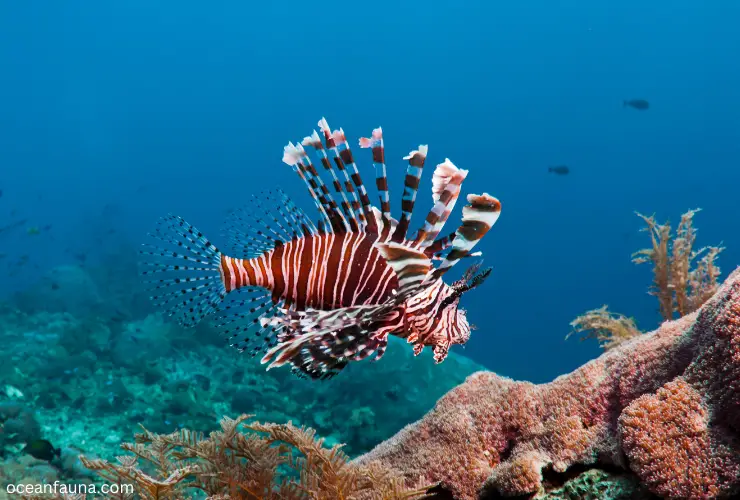
Anatomy of Red Lionfish
Here is a breakdown of the red lionfish’s anatomical organ system:
Skeletal System
Like most other fish, the red lionfish has a bony skeleton. Its skeleton is made up of the head, vertebrae, ribs, and fin rays. The spines on its dorsal, anal, and pelvic fins are also part of its skeletal system.
Muscular System
The red lionfish has strong, flexible muscles that allow it to swim and hunt prey. Its fins are especially important for maneuverability, with the pectoral fins used for steering and the dorsal, anal, and pelvic fins used for stabilization.
Digestive System
The red lionfish has a mouth with sharp teeth, which it uses to catch and eat small fish and invertebrates. Its digestive system consists of a short esophagus, stomach, and intestines, with waste expelled through the anus.
Circulatory System
The red lionfish has a closed circulatory system, meaning its blood is contained within blood vessels. Its heart has two chambers: one that receives oxygen-depleted blood from the body and pumps it to the gills, and another that receives oxygenated blood from the gills and pumps it back out to the body.
Respiratory System
The red lionfish breathes through its gills like all fish. It takes water through its mouth, then passes over the gill arches. Oxygen is extracted from the water, and carbon dioxide is released back into the water.
Nervous System
The red lionfish has a well-developed nervous system with a brain and spinal cord. It also has a lateral line system, which allows it to sense vibrations in the water and detect the movement of nearby prey.
What Do Red Lionfish Eat?
Red lionfish are notorious for their voracious appetite and predatory skills. Their diet consists of more than 70 marine fish and invertebrate species, including yellowtail snapper, Nassau grouper, parrotfish, banded coral shrimp, and even other lionfish.
These hunters are known for their stalking behavior, often using their intricate patterns and coloration to blend into their surroundings and ambush unsuspecting prey. Once they have spotted their target, they will use their large, pectoral fins to corral them into a corner, making escape impossible.
Red lionfish are incredibly skilled at hunting, using a combination of speed, agility, and deadly venom to capture their prey. Their venomous spines can cause painful stings to both predators and humans, making them a formidable force in the underwater world.
Despite their feared reputation, lionfish also play an important role in the marine ecosystem. They help to control the population of smaller fish and invertebrates, contributing to the delicate balance of the underwater food chain.
Regarding nutrition, red lionfish are high in protein and omega-3 fatty acids, making them a popular target for commercial fishing. However, their venomous spines can make them dangerous to harvest and handle, requiring specialized techniques for safe consumption.
Where Do Red Lionfish Live?
Red Lionfish, also known as Pterois volitans, are typically native to the warm tropical waters of the South Pacific and Indian Oceans. Specifically, they are found in the Indo-Pacific region, including the Red Sea. Interestingly, as an invasive species, they have also spread to other parts of the world, such as the Caribbean and the Atlantic Ocean.
In terms of habitat, Red Lionfish are known to live in a variety of marine habitats. They have been found in most marine habitat types that are found in the warm marine waters of the tropics.
This includes a hard bottom, mangrove, seagrass, coral, and artificial reefs like shipwrecks. The Red Lionfish can adapt easily to different environments and can be found in water depths ranging from 1 to 300 feet.
The Red Lionfish is a popular saltwater fish in the aquarium trade, which makes it the most widely distributed non-native marine fish species in the United States. The fish are commonly found in subtropical and tropical waters but have also been sighted in cooler environments. Notably, It is said that the lionfish population has had a negative impact on the coral reefs by feeding on juvenile fish and small invertebrates.
How Big Is a Red Lionfish?
The red lionfish is a species that can grow to an average length of 12-15 inches (30.5-38 cm). These lionfish can weigh up to 2.6 lbs. (1.18 kg), making them relatively average in size compared to other lionfish species.
However, the size and weight of a red lionfish can vary depending on a number of factors, such as its age, diet, and habitat. In some cases, these fish may grow to be even larger than 15 inches or weigh more than 2.6 lbs.
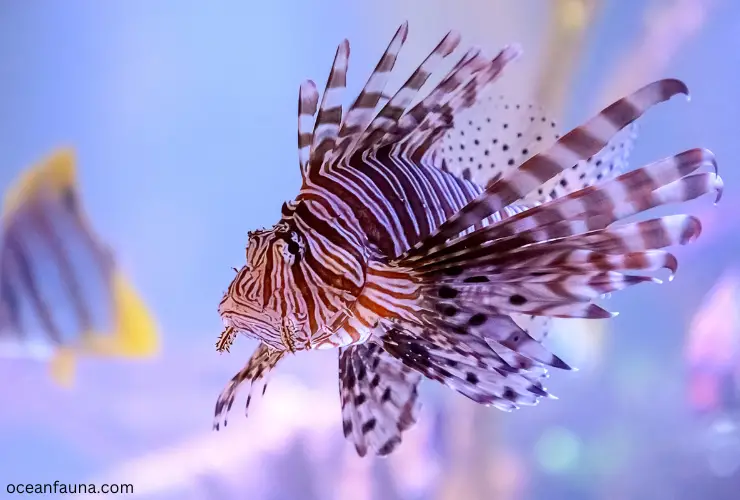
Reproduction and Life Cycle of Red Lionfish
The reproductive process of the red lionfish is a fascinating phenomenon. The female lionfish lays numerous eggs of considerable size in two gelatinous masses that float in seawater for as long as 25 days. These eggs can number from 12,000 to 15,000 in each egg mass, and the female lionfish can produce these masses every four days in warm waters.
The mating process of red lionfish has not been fully documented, but it is presumed to involve the courtship and pairing of males and females.
The pelagic egg masses of lionfish are fertilized externally in the water, as the male lionfish releases his sperm into the water to join the eggs. The resulting larvae are planktonic and spend several weeks drifting in the open ocean before they ultimately settle onto the reef as juveniles.
The larvae are born with spines and are capable of fending off predators that typically prey on them at this age.
As juveniles, red lionfish have a reddish-brown coloration with white stripes on their bodies. They develop distinct patterns and colorations as they grow and mature into fully-grown adults.
Lionfish can be a threat to the ecosystem when introduced to non-native waters, as they have no natural predators and are efficient hunters. Overall, the red lionfish’s life cycle and reproductive processes are a testament to the survival skills and adaptability of marine life.
What Is the Lifespan of Red Lionfish?
The lifespan of Red Lionfish is still unknown in the wild. However, in captivity, these beautiful and venomous creatures are known to live for approximately ten years. The lifespan of Red Lionfish can vary depending on various factors, including the quality of their habitat, availability of food, and other environmental factors.
Red lionfish are infamous for their ability to survive in various environments, including shallow reefs and deep waters. Their unique appearance and captivating behavior make them a favorite among marine enthusiasts.
These fish are also known for their venomous spines, which are used for defense purposes. Handling these creatures with caution is critical, as their stings can cause painful and potentially serious reactions.
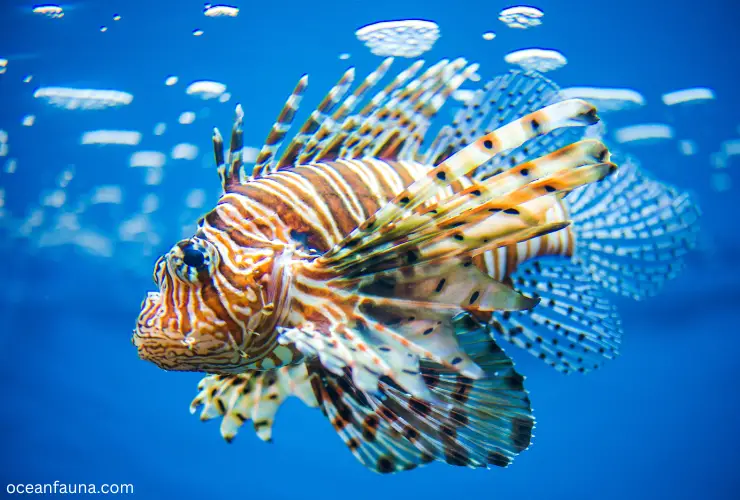
Are Red Lionfish Venomous?
Yes, red lionfish are highly venomous. The venom contained in their 18 dorsal, pelvic, and anal fin spines can cause intense pain, nausea, and even temporary paralysis. The pain from a lionfish sting can last for hours and, sometimes, even require hospitalization.
While it’s uncommon for lionfish stings to be fatal to humans, it’s mandatory to seek medical attention immediately if you are stung.
Additionally, rinsing the affected area in hot water can help to neutralize the venom and provide some relief. It’s worth noting that lionfish are an invasive species in many areas and can cause significant damage to local ecosystems.
Considering their venomous nature and possible damage to the environment, handle them cautiously and only interact with them if you are trained professionally.
Impact on Bio Diversity of Ref Lionfish
Lionfish are known to have a significant impact on the bio-diversity of reefs, demonstrating both positive and negative effects on the overall health of the marine ecosystem.
Positive Effects of Lionfish
Lionfish are known to control the population of small reef fish, such as damselfish, which can prevent them from overgrazing on the reef’s algae. This, in turn, can lead to a healthier reef ecosystem, as the algae serve as a primary food source for many marine organisms.
Moreover, lionfish are a popular game fish in many areas where they are invasive, providing a source of income for local communities through recreational fishing.
Negative Effects of Lionfish
Despite their positive ecological impact on the reefs, however, lionfish can pose a significant threat to the biodiversity of marine ecosystems.
Lionfish are opportunistic feeders, consuming a wide range of prey, including juvenile fish, crustaceans, and mollusks. This can reduce the number of key prey species and, in turn, the survival rate of apex predators such as sharks and barracudas.
Furthermore, lionfish have been known to reduce the population of herbivorous fish such as parrotfish, which play a vital role in keeping the reefs healthy by grazing on algae that might otherwise overgrow and damage the reef.
Is There Any Predator of Red Lionfish?
Due to their venomous spines, they have very few natural predators in their non-native environments. However, a few species of groupers, eels, and sharks have been known to prey on lionfish.
Groupers, in particular, have been observed preying on lionfish in the Caribbean region. Studies have shown that groupers are able to consume lionfish without harm due to their thick lips and bony tongues, which protect them from being stung by the spines.
In fact, some grouper species have been known to actively hunt for lionfish, making them an important ecological control measure for this invasive species.
Similarly, some eel species, such as the green moray eel, have been observed feeding on lionfish by grabbing them with their jaws. Eels are also immune to the lionfish’s venomous spines, allowing them to safely prey on these invasive fish.
Lastly, a few species of shark have been known to occasionally feed on lionfish. While sharks are not considered a significant predator of lionfish, their predatory behavior towards these fish could help to control their populations in certain areas.
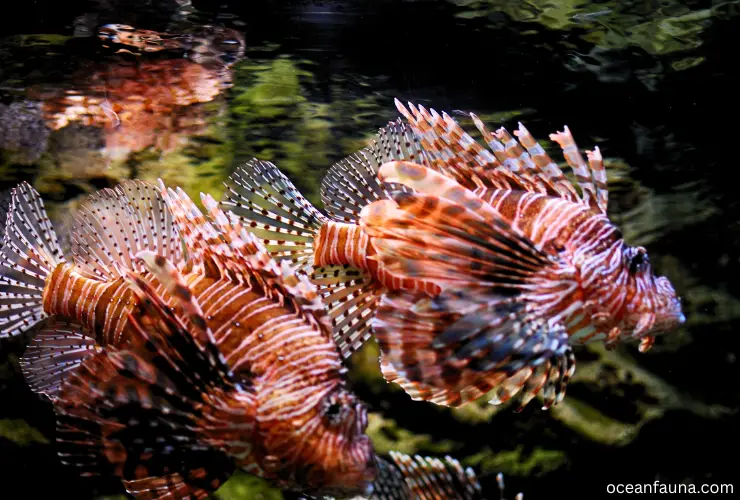
What Is the Conservation Status of Red Lionfish?
According to the assessment conducted in 2015 by The IUCN Red List of Threatened Species, the conservation status of the Red Lionfish (Pterois volitans) has been determined as the Least Concern. This means that this species is not currently facing any significant threats or risks of extinction.
With their captivating and vivid coloration, Red Lionfish make a stunning addition to any oceanic environment.
However, these magnificent creatures have been unintentionally introduced into parts of the world where they weren’t previously present — such as the Caribbean Sea and North American Atlantic Coast — which has caused alarm among ecologists due to their potential for disrupting local ecosystems with their venomous spines.
Despite these concerns, the overall population of Red Lionfish appears to be stable and abundant enough to support their continued existence. Additionally, efforts are being made in some areas to control their population and prevent them from becoming invasive.
How to Keep Red Lionfish in Aquarium?
Keeping Red Lionfish in an aquarium requires careful consideration of their habitat needs. If you want to keep them, here are some key factors to consider.
Habitat Requirements
Red lionfish require an aquarium that is at least 75 gallons or larger. This is because these fish can grow up to 15 inches in size and require plenty of open swimming space. The tank should also have a number of hiding places, such as crevices and caves, as this mimics their natural habitat.
Water Parameters
The water in the aquarium should be kept at a temperature between 75-80°F, with a pH level between 8.1-8.4. The salinity level should be between 1.020-1.025, and the water should be well-aerated and filtered.
Feeding
Red lionfish are carnivorous and require a diet of live or frozen meaty foods such as shrimp, krill, and squid. They have a voracious appetite and should be fed several times a week. Lionfish have venomous spines and can be dangerous when feeding, so it is essential to take precautions during feeding time.
Behavior and Compatibility
Red lionfish are relatively peaceful with other fish but are predatory and should not be housed with smaller fish or invertebrates as they may become prey. Also, these fish are active at night, so keeping a lower light level in the tank is recommended to provide better viewing.
Popular Mythology and Folklore surrounding Red Lionfish
The Red Lionfish has been a part of mythology and folklore in many cultures throughout history. In some cultures, they are believed to have healing properties and are used in traditional medicine. In others, they are associated with bad luck or evil spirits.
Conclusion
The Red Lionfish is a fascinating and beautiful fish species. Their unique anatomy, diet, habitat, lifespan, reproduction, ecological impact, conservation status, and popular mythology make them a subject of interest for marine biologists, aquarium enthusiasts, and researchers.
However, their introduction to non-native habitats has had a negative impact on the marine ecosystem, and efforts are being made to control their population. As a responsible aquarium enthusiast, be aware of our actions impact on the environment and take steps to minimize that impact.

